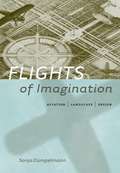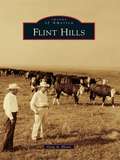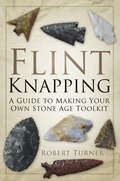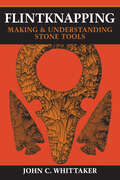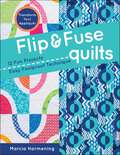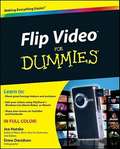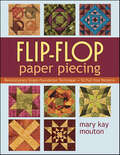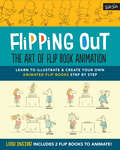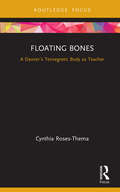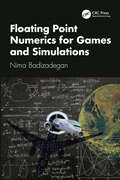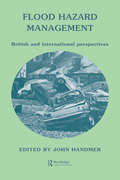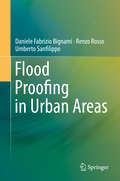- Table View
- List View
Flights of Imagination
by Sonja DümpelmannIn much the same way that views of the earth from the Apollo missions in the late 1960s and early 1970s led indirectly to the inauguration of Earth Day and the modern environmental movement, the dawn of aviation ushered in a radically new way for architects, landscape designers, urban planners, geographers, and archaeologists to look at cities and landscapes. As icons of modernity, airports facilitated the development of a global economy during the twentieth and early twenty-first centuries, reshaping the way people thought about the world around them. Professionals of the built environment awoke to the possibilities offered by the airports themselves as sites of design and by the electrifying new aerial perspective on landscape. In Flights of Imagination, Sonja Dümpelmann follows the evolution of airports from their conceptualization as landscapes and cities to modern-day plans to turn decommissioned airports into public urban parks. The author discusses landscape design and planning activities that were motivated, legitimized, and facilitated by the aerial view. She also shows how viewing the earth from above redirected attention to bodily experience on the ground and illustrates how design professionals understood the aerial view as simultaneously abstract and experiential, detailed and contextual, harmful and essential. Along the way, Dümpelmann traces this multiple dialectic from the 1920s to the land-camouflage activities during World War II, and from the environmental and landscape planning initiatives of the 1960s through today.
Flint Hills
by Greg A. HootsThe Kansas Flint Hills stretch across a dozen counties in the eastern half of the Sunflower State. The region boasts rolling hills covered in native grasses, including the tallgrass varieties unique to the area. Dubbed the "Great American Desert" by pioneers facing the prairie's vastness, the rich grassland became home to settlers pursuing ranching and farming enterprises. Images of America: Flint Hills presents over 200 historic images from a half-dozen counties in the region. Included are vintage photographs from the Native Stone Scenic Byway and the Flint Hills Scenic Byway that transverse the district. Also included are views of Council Grove, the last place that travelers could purchase supplies before leaving on the Santa Fe Trail. The Davis Ranch, which encompassed all of what is now the Tallgrass Prairie Preserve, is seen in historic images never published before. The volume concludes with photographs of Flint Hills cowboys at work and at play.
Flint Knapping: A Guide to Making Your Own Stone Age Toolkit
by Robert TurnerFlint knapping, which is the shaping of flint or other fracturing stone to manufacture tools, was one of the primary skills used for survival by our prehistoric ancestors. Early mankind once made and used these implements on a daily basis to hunt, prepare food and clothing, to farm, make shelters, and perform all the other tasks required for Stone Age existence.A material that has been with us since earliest times, flint still plays a part in our lives today: it is used in cigarette, gas and barbeque lighters; in some parts of Britain it is a major building material; and many of our beaches have shingle which is just flint by another name.In this informative and original guide, expert Robert Turner explains how flint was used, what tools were made and what they were made for, and provides detailed instruction of how to make them, enabling the reader to replicate their own Stone Age toolkit. Illustrated throughout, Flint Knapping is a journey of archaeological discovery through the Palaeolithic, Mesolithic, Neolithic and Bronze Ages.
Flintknapping: Making & Understanding Stone Tools
by John C. WhittakerA detailed, practical guide to the ancient craft of making stone tools, featuring an archaeological analysis.Flintknapping is an ancient craft enjoying a resurgence of interest among both amateur and professional students of prehistoric cultures. In this guide, John C. Whittaker offers the most detailed handbook on flintknapping currently available and the only one written from the archaeological perspective of interpreting stone tools as well as making them.Flintknapping contains detailed, practical information on making stone tools. Whittaker starts at the beginner level and progresses to discussion of a wide range of techniques. He includes information on necessary tools and materials, as well as step-by-step instructions for making several basic stone tool types. Numerous diagrams allow the reader to visualize the flintknapping process, and drawings of many stone tools illustrate the discussions and serve as models for beginning knappers.Written for a wide amateur and professional audience, Flintknapping will be essential for practicing knappers as well as for teachers of the history of technology, experimental archaeology, and stone tool analysis.“A mid-range user’s guide to flintknapping is long overdue. There have been some admirable attempts to produce such a volume, but these have been targeted at specific, fairly narrow audiences. Not so with Flintknapping. . . . [Whittaker’s] clear aim is to reach professional archaeologists as well as hobbyists. I believe he achieves this goal with incredible skill and humor. . . . I highly recommend this book to everyone interested in flintknapping.” —Plains Anthropologist“Very attractive to readers interested in ancient crafts, survival skills, or the history of technology . . . . Far superior to anything currently available.” —James C. Woods, director, The Herrett Museum, College of Southern Idaho
Flip & Fuse Quilts
by Marcia HarmeningCheat Your Way to Foolproof Appliqué Say goodbye to tedious hand stitching and scruffy raw-edge appliqué with the incredible Flip & Fuse method! Sew 12 complex-looking quilts with precision, sharp lines, and easy curves. Turned edge appliqué with Flip & Fuse will save you time and hassle. If you’ve appliquéd your last chicken, you’ll appreciate these bold, geometric designs as a sophisticated alternative to old-school silhouettes. Learn quilting tips, incorporate fussy-cut designs, and make projects in multiple sizes. Even if you’ve been unsuccessful with other appliqué methods, you’ll love how easy it is to Flip & Fuse! • Transform the way you appliqué with the revolutionary Flip & Fuse method • A simple and accurate method with easy-to-use patterns designed for speed and economy • Foolproof way to make complex-looking quilts with patterns in multiple sizes
Flip Video For Dummies
by Joel Hutsko Drew DavidsonThe full-color guide to shooting great video with the Flip Video camera The inexpensive Flip Video camera is currently one of the hottest must-have gadgets. It's portable and connects easily to any computer to transfer video you shoot onto your PC or Mac. Although the Flip Video camera comes with a quick-start guide, it lacks a how-to manual, and this full-color book fills that void! Packed with full-color screen shots throughout, Flip Video For Dummies shows you how to shoot the best possible footage in a variety of situations. You'll learn how to transfer video to your computer and then edit it and share your Flip Video movies. Walks you through the basics of using a Flip Video camera and connecting it to your Mac or PC Explains how to shoot footage indoors, outdoors, and even underwater Covers editing video footage using FlipShare, Windows Movie Maker, or iMovie Shows you how to share Flip Video movies or upload them to YouTube, Facebook, and other sites You'll flip out when you discover just how easy a Flip Video camera can be when you have this book by your side!
Flip! for Decorating
by Elizabeth MayhewIn this fresh, fun, and unique book, design consultant and Today show lifestyle expert Elizabeth Mayhew shares essential insider tips for making any space stylish and timeless in a snap. Forget expensive fixes or labor-intensive endeavors, Flip! for Decorating can show you how to redecorate with what you have on hand, or with the simple purchases you'll need to create the room of your dreams. Flip through the upper right hand pages, and watch four rooms receive an instant makeover! Inside you'll discover:* step-by-step instructions for decorating the four most commonly used rooms: living room, dining room, family room, and bedroom* the fundamentals of color, including no-fail wall and trim colors, when to use wallpaper instead of paint, and the facts on different paint finishes* the ways to treat a window, from Venetian blinds and Roman shades to simple curtains-and the secrets to making a window appear taller or wider* the art of picking the perfect sofa, chairs, tables, and lighting* strategies on how to prioritize your decorating decisionsFlip! for Decorating also features time-saving "reality checks," handy shopping tips, and easy and informative sidebars that will give you instant solutions if you're stumped, stymied, or need to add a quick jolt of style to virtually any room in your home. With this amazing, practical book, decorating is so easy you'll flip!
Flip-Flop Paper Piecing
by Mary Kay MoutonPaper-Piece Dozens of Blocks You Never Could Before • Revolutionary single-foundation technique makes those hard-to-piece blocks easy to assemble with perfect accuracy • Paper piece Attic Window and Jewel blocks with no Y-seams! • Simplify your piecing on miniature and small-scale quilts • Get started right away with full-size foundations for 26 different blocks, each in 2 finished sizes: 2 1/4" and 6" • Includes complete instructions for a beautiful Flip-Flop sampler quilt If you're a paper piecer, you're used to flawless accuracy and crisp, sharp points. But what about all those blocks that give you headaches, like Ohio Star, Delectable Mountain, or Attic Window? This new, single-foundation technique is the answer. No more multiple foundations! No more Y-seams! Paper piecing is foolproof when you're a flip-flopper! *Important Note about PRINT ON DEMAND Editions: This title will be printed after purchase and will arrive separately from any in-stock items. Please allow approximately 2 weeks for USA delivery, with an additional 2 weeks for international shipments. Expedited shipping is not available on POD Editions. The printing quality in this copy will vary from the original offset printing edition and may look more saturated due to printing on demand by a high-quality printer on uncoated (non-glossy) paper. The information presented in this version is the same as the most recent printed edition. Any pattern pullouts have been separated and presented as single pages.
Flipping Out: The Art of Flip Book Animation
by David HurtadoLearn to create an animated flip book from start to finish! Flipping Out: The Art of Flip Book Animation guides readers through the entire flip book animation process, from brainstorming and storyboarding, to drawing, adding color, and more. Aspiring animators will learn all of the skills to create flip books of their own, including keyframes, in-betweens, animating characters, and binding their animations into a book. Using the enclosed drawing pencil and step-by-step lessons as a guide, readers can then animate and personalize the two blank flip books included inside.
Floating Bones: A Dancer's Tensegretic Body as Teacher
by Cynthia Roses-ThemaFloating Bones charts the author’s journey into tensegrity, which begins in ballet and culminates in a model for addressing one’s body as a teacher. Tensegrity flips traditional biomechanical models such that instead of support coming from the bones, the bones float, and it is the muscles and other soft connective tissue that provide support for the moving body. Using the model of tensegretic experience, Roses-Thema connects somatics, cognition, rhetoric, and reflective practices detailing the means that constructed approaching the body as a teacher. This study presents the argument for extending the models of thinking to include bodily thinking, by citing how the experiential perspective of tensegrity constructs physical evidence of the rhetorical concept, metis, where the body thinks as it moves. This book will be of great interest to students, scholars, and practitioners of dance, theater, and sociology.
Floating Point Numerics for Games and Simulations
by Nima BadizadeganFloating point is ubiquitous in computers, where it is the default way to represent non-integer numbers. However, few people understand it. We all see weird behavior sometimes, and many programmers treat it as a mystical and imprecise system of math that just works until it sometimes doesn’t. We hear that we shouldn’t trust floating point with money, we know that 0.1 + 0.2 does not equal 0.3, and “NaN” shows up in our logs when things break. We rarely hear why any of this is the case, and less about what to do about it.This book pulls back the veil on floating point and shows how this number system we program with every day works. It discusses how to leverage the number system for common calculations, particularly in graphics and simulations, and avoid pitfalls. Further, we will review methods that can give you either better performance or better accuracy on tasks like numerical integration and function approximation, so you can learn to make the right tradeoffs in your programs.This book builds upon a basic knowledge of calculus and linear algebra, working with illustrative examples that demonstrate concepts rather than relying on theoretical proofs. Along the way, we will learn why Minecraft has struggled with boat physics and what the heck John Carmack was thinking with Quake III’s infamous fast reciprocal square root algorithm. By the end of the book, you will be able to understand how to work with floating point in a practical sense, from tracking down and preventing error in small calculations to choosing numerical building blocks for complex 3D simulations. Gives insight into how and why floating-point math works Describes how floating-point error arises and how to avoid it Surveys numerical methods important to graphics and numerical simulations Includes modern techniques to apply to your numerical problems Shows how to hack the floating-point numbers to compute faster and more accurately
Flood Hazard Management: British And International Perspectives
by John HandmerIn some important respects floodplain management and flood hazard research is different in Britain from that in other countries. This collection of papers from a conference provides some comparisons. It covers urban flooding, institutions and policy, land use policy, hazard response, and project appraisal and risk assessment.
Flood Proofing in Urban Areas
by Daniele Fabrizio Bignami Renzo Rosso Umberto SanfilippoFlood control in urban areas can be feasibly and cost-effectively enhanced by implementing flood proofing approaches to risk reduction in the context of environmental and land-use planning and management. Indeed, flood proofing makes it possible to improve, integrate and in some cases even replace traditional measures for flood control, reducing the vulnerability and increasing the resilience of buildings and infrastructures.This book begins by reviewing the physics of stability and instability of both human beings and buildings under flood conditions, together with criteria and models (both conventional and innovative) for assessing flood strains. In turn, it presents a range of flood proofing concepts and techniques, together with a complete and updated classification of related methods and devices. This provides a user-friendly tool to help identify appropriate solutions to real-world problems for each specific risk scenario.In particular, the book focuses on temporary flood proofing techniques, given their ability to deliver effective performance at low costs. Lastly, it features an overview of norms, guidelines and laboratory recommendations that are currently being adopted in various countries with regard to flood proofing devices and testing procedures.The purpose of this book is essentially to encourage authorities, stakeholders, technicians and end users to successfully develop flood proofing solutions that can reduce flood risk in a pragmatic manner. In addition, the authors hope to inspire researchers, manufacturers and designers (engineers, architects, urban planners and urban managers) to pursue further advances in this key sector of public and private safety in urban areas.
Floodplain Management: A New Approach for a New Era
by Julie Clark Susan Bolton Bob Freitag Frank WesterlundA flooding river is very hard to stop. Many residents of the United States have discovered this the hard way. Right now, over five million Americans hold flood insurance policies from the National Flood Insurance Program, which estimates that flooding causes at least six billion dollars in damages every year. Like rivers after a rainstorm, the financial costs are rising along with the toll on residents. And the worst is probably yet to come. Most scientists believe that global climate change will result in increases in flooding. The authors of this book present a straightforward argument: the time to stop a flooding rivers is before is before it floods. Floodplain Management outlines a new paradigm for flood management, one that emphasizes cost-effective, long-term success by integrating physical, chemical, and biological systems with our societal capabilities. It describes our present flood management practices, which are often based on dam or levee projects that do not incorporate the latest understandings about river processes. And it suggests that a better solution is to work with the natural tendencies of the river: retreat from the floodplain by preventing future development (and sometimes even removing existing structures); accommodate the effects of floodwaters with building practices; and protect assets with nonstructural measures if possible, and with large structural projects only if absolutely necessary.
Floods of Northern New Jersey (Images of America)
by North Jersey Media Group Amre YoussefSituated between winding rivers and prone to turbulent storms, northern New Jersey has had an extensive and tumultuous history of flooding. The most severe flood occurred in 1903 when three days of nonstop rain, averaging 12 inches per day, melted more than 23 inches of snow and ice�inundating the cities of Passaic and Wallington and splitting Paterson in two. Since 1945, more than 60 documented storms have wreaked havoc and shaken the region. In 2011, the second-worst storm in North Jersey�s history, Hurricane Irene, struck with more than 11 inches of rain, displacing 6,000 residents in Paterson alone and hitting Bergen and Passaic Counties with a vengeance. Only one year later, Superstorm Sandy rolled into North Jersey, flooding Moonachie and Little Ferry with surges up to five feet. Floods of Northern New Jersey showcases the rich documentation of flooding through a unique and significant photographic collection.
Floor Sample: A Creative Memoir
by Julia CameronFloor Sample is a memoir from the Queen of Creativity, Julia Cameron…Julia Cameron has transformed the creative lives of millions, showing them that creativity is their uniquely human birthright. But long before the tools of The Artist’s Way changed the conversation around creativity, Julia developed and used them in her own life.Floor Sample is the story behind an artistic life—detailing Julia's years in New York, her time as a writer for Rolling Stone, her turbulent marriage to Martin Scorsese, and her painful struggle with alcohol, which ultimately led her to recovery and the methods that would form the backbone of The Artist’s Way. The life Julia shares in her memoir is tempestuous, flitting restlessly across the country, falling in and out of love, wrestling with alcohol and mental health, but through all of it, always, her art was a fixed point and north star. Featuring a brand new prologue from the author, Floor Sample is honest and unapologetic, a glimpse into the heart and mind behind The Artist’s Way.
Floorquilts!: Fabric Decoupaged Floorcloths—No-Sew Fun
by Ellen Highsmith SilverTurn your favorite fabrics and quilt patterns into practical, durable art with twelve no-sew projects including floorcloths, placemats, and more! Easier to make than a conventional quilt or a painted floorcloth, a Floorquilt is the perfect way to turn the fabric you love into a masterpiece you can use. Ellen Highsmith Silver teaches you the simple decoupage techniques you need to transform a piece of canvas into a beautiful, durable floorcloth—plus coasters, placemats, trivets, serving trays, and even dbookmarks! Each project features illustrated easy-to-follow instructions. Ellen guides you every step of the way, from choosing raw fabric to applying a protective finish to the completed Floorquilt. Lots of how-to photographs and inspiring examples
Flop Musicals of the Twenty-First Century: How They Happened, When They Happened (And What We’ve Learned)
by Stephen PurdyFlop Musicals of the Twenty-First Century offers a provocative and revealing historical narrative of a group of musicals that cost millions, that were created by world-renowned writers and directors, and that had spectacular potential… but bombed anyway. Stephen Purdy asks the reader to consider what the legendary creators of Les Misérables, pop superstar Elton John, and wunderkind Julie Taymor have in common besides being inspired storytellers of iconic Broadway musicals. The answer is that they also all created shows that, for one reason or a dozen, flopped. This book shares the story of what can happen when formidable creative teams of sell-out musicals attempt to repeat their success but miss the mark. First-hand accounts from the cast members, backstage staff, and the creative team, combined with a wealth of secondary sources gathered from press articles, reviews, and critical commentary, offer an intriguing insight into the factors behind success and failure in the musical theatre business. This is a fascinating book for students, scholars, practitioners, and fans of musical theatre that contains thoughtful observations about luck and creative differences, botched adaptations, and alienated audiences, all of which can determine the fate of a musical.
Flop Musicals of the Twenty-First Century: Part I: The Creatives
by Stephen PurdyFlop Musicals of the Twenty-First Century offers a provocative and revealing historical narrative of a group of musicals that cost millions and had spectacular potential ... but bombed anyway. Stephen Purdy examines at length the production histories, which are all bound together by a common thread. The book focuses the lens on several seemingly infallible theatre creatives who weren’t destined to repeat their successes with the shows discussed in this volume. As such, Purdy grounds the discussion by examining what the legendary creators of Les Misérables, pop superstar Elton John, wunderkind Julie Taymor, and many others have in common besides being inspired storytellers of iconic Broadway musicals. The answer is that they also all created shows that, for one reason or a dozen, didn’t find an audience. Flop Musicals of the Twenty-First Century shares the story of what can happen when formidable creative teams of sell-out musicals attempt to re-create their success but miss the mark. This is an engaging book for students, practitioners, and fans of musical theatre that contains thoughtful observations about luck and creative differences, botched adaptations, and alienated audiences, all of which can determine the fate of a musical.
Flora Fantastic: From Orchidelirium to Ecocritical Contemporary Art (ISSN)
by Corina L. Apostol Tashima ThomasThis book delves deep into colonial botany, utilizing mediums such as historical investigation, cinema, photography, live performance, and installation art.Surveying perspectives from Europe, the U.S., Africa, Southeast Asia, Latin America, and the Caribbean, it positions plants—both native and foreign—as active participants and silent observers in colonial narratives. By viewing through the prism of visual and performance art, this book touches on diverse topics like the economic value of plants, traditional and Western medicine, state‑endorsed scientific endeavors, migration patterns of flora and people, bio‑contact areas, nationalistic views, and botanical diplomacy. It offers fresh insights into colonial botany’s multifaceted history, emphasizing the intricate interplay between Eastern, Western, and Southern nations during the twentieth century and its enduring impact today.Serving as an invaluable addition to the realms of art history, performance studies, botany, visual culture, decolonial initiatives, and environmental politics, this book arrives at a pivotal moment when its insights are most crucial.
Flora Nouveaux: Not Your Grandma's Dried Flowers
by Carla Wingett“A must-buy that will quickly gain fans among those who want to make their own bouquets as well as anyone who just likes to look at beautiful arrangements. This work deserves the spotlight on any shelf” —Library Journal, Starred ReviewEmbrace the unique and sustainable beauty of dried flowers with this bright, fun, and modern flower book from Carla Wingett, popular flower designer and founder of Idlewild Floral.Move over dusty, neutral bouquets! Dried flowers get a much-needed makeover in Flora Nouveaux, a contemporary color-forward take on dried floral arrangements. Combining hundreds of gorgeous images with easy-to-follow how-to guidance on drying and arranging stunning blooms, expert florist Carla Wingett puts the power in your hands to easily create spectacular, sustainable, showstopping dried arrangements for any occasion. Turn the pages of this one-of-a-kind guide to find:Twenty gorgeous, contemporary floral recipes that add a pop of striking, eco-friendly beauty to every scene and subvert expectations of what dried flowers can be.Sections organized by occasion, including everyday living, holidays, entertaining, and ceremonies.Simple techniques for sourcing, drying, and preserving dried flowers, plus bonus tips on enhancing your arrangements with fresh elements. Whether you want to jazz up your kitchen counter with an everlasting bouquet, add a festive wreath to your holiday table, or wow your wedding guests with an exquisite floral installation, Flora Nouveaux gives you all the tools to create magic with dried flowers. EXPERT AUTHOR: Carla Wingett is the founder of Idlewild Floral, a boutique floral design company based in California that works exclusively with dried and preserved flowers. Her work has been featured in Food & Wine Magazine, Martha Stewart, Dwell, Architectural Digest, and Forbes, sharing Idlewild’s distinctive style and contemporary take on floral design.DRIED FLORAL DÉCOR: Dried flower arranging has become popular year-round as a winning option for more earth-friendly and reusable décor. This book makes it easy to incorporate the trend into your home and special events. It makes the perfect gift or self-purchase for flower lovers. AFFORDABLE LUXURY: This arranging guide is chock-full of essential wisdom and dozens of inspired ideas for decorating with dried flowers. It’s just right for flower and decor enthusiasts looking for affordable ways to elevate their homes and workspaces. Pair it with a starter set of dried or preserved flowers or a lovely ceramic vase to create a charming gift package.Perfect for:Flower loversCrafters and decor enthusiasts of all skill levelsGift-giving for housewarming, engagement, birthday, Mother's Day, and moreFans of Floret Farm’s flower books, Magnolia Table, and The Flower Recipe Book
Flora's Empire
by Eugenia W. HerbertLike their penchant for clubs, cricket, and hunting, the planting of English gardens by the British in India reflected an understandable need on the part of expatriates to replicate home as much as possible in an alien environment. In Flora's Empire, Eugenia W. Herbert argues that more than simple nostalgia or homesickness lay at the root of this "garden imperialism," however. Drawing on a wealth of period illustrations and personal accounts, many of them little known, she traces the significance of gardens in the long history of British relations with the subcontinent. To British eyes, she demonstrates, India was an untamed land that needed the visible stamp of civilization that gardens in their many guises could convey.Colonial gardens changed over time, from the "garden houses" of eighteenth-century nabobs modeled on English country estates to the herbaceous borders, gravel walks, and well-trimmed lawns of Victorian civil servants. As the British extended their rule, they found that hill stations like Simla offered an ideal retreat from the unbearable heat of the plains and a place to coax English flowers into bloom. Furthermore, India was part of the global network of botanical exploration and collecting that gathered up the world's plants for transport to great imperial centers such as Kew. And it is through colonial gardens that one may track the evolution of imperial ideas of governance. Every Government House and Residency was carefully landscaped to reflect current ideals of an ordered society. At Independence in 1947 the British left behind a lasting legacy in their gardens, one still reflected in the design of parks and information technology campuses and in the horticultural practices of home gardeners who continue to send away to England for seeds.
Floragami
by Armin TäubnerCreate stylized versions of real flowers, whimsical fantasy flowers, and beautiful floral balls and wreaths--40 designs in all--using cut, folded, and glued paper. Step-by-step folding instructions are included, with hundreds of color diagrams.
Floral Abundance Quilt
by Deborah KemballA delightful appliqué bouquet Craving more gorgeous appliqué from award-winning author Deborah Kemball? This pattern pack includes complete instructions and full-size pattern sheets for a floral quilt (52˝ × 52˝) in two colorways, plus instructions to turn any of the 9 blocks into a sophisticated pillow. Stitch the 24 motifs using needleturn appliqué, then embellish with embroidery stitches. Simpler than they appear, these detailed projects are a joy to create. • Exuberant mix of floral motifs in the author’s signature style • Basics section covers hand appliqué with freezer paper or plastic templates • Two projects for the price of one! Blocks, pillows, and borders, too
Floral Crochet
by Mary Carolyn WaldrepRenewed interest in needlecraft projects -- particularly in crocheted items used as accent pieces -- has created a new demand for attractive floral patterns. Fashionable during the first half of the twentieth century, these popular designs ranged from the simple, stylized motifs found in edgings and tablecloths to superb bouquets of three-dimensional blossoms used in bedspreads, placemats, and doilies.With the patterns in this splendid collection, crocheters can again re-create many of the same eye-catching designs that were once presented in now-rare thread-company instruction booklets of the 1940s and '50s. Included here are designs for a delicate three-piece filet crochet vanity set displaying the timeless beauty of the daffodil; exquisite edgings depicting violets, fuchsias, and begonias; a lovely bedspread titled Friendship Garden; a Rose O' Summer doily centerpiece; a breathtaking doily set titled Forget-Me-Not Swirl; a variety of colorful pansy motifs incorporated in a bedspread, refreshment set, and two different doilies; a lacy lily-of-the-valley doily; and two dozen other irresistible designs.Easy-to-follow, step-by-step instructions and 36 finely detailed photographs enable crocheters at all levels to create a treasure chest of stunning, heirloom-quality items. In addition, a brief introduction provides helpful hints on how to care for completed projects through proper washing and blocking.
